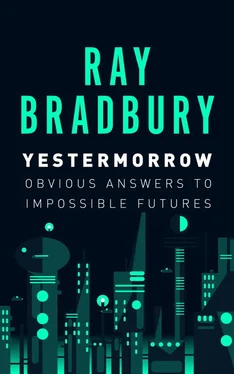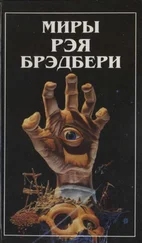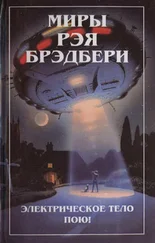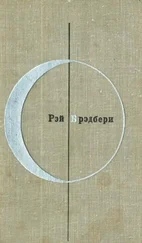My job there in theater? To seize a few dozen audio-animatronic robot humanoid creatures and fashion a five-billion-year history of Earth coming out of the sun, cooling and bringing forth in its seas the animalcules that one would one day shape spines, and stride in teeming apecrews of men, women, and children, using fire along the way.
I had Michelangelo spring feverishly from the platform pit as artist magician, a robot who pointed over the audiences’ heads and ordered the ceilings to change. Then I blueprinted the hidden and miraculous machineries of this extraordinary theater to paint, before their uplifted gaze, the Sistine Chapel ceiling and walls over and around and above them. In two minutes flat they would experience what it took Michelangelo hundreds of days to paint.
Supertheater. Wouldn’t you, wouldn’t I, like to be in a theater where we could see that happen at least once a year every year of our lives?
For this experience, acted out by robots, accompanied by orchestras and voices, I imagined ape-men robots who, before your eyes, turned into Egyptian priests, then divested themselves to become da Vinci among his fabled machines, Ben Franklin struck to ashes by lightning, the Wright brothers, goggled and elated on Kitty Hawk sand dunes, and finally a man of the future, X-rayed, in whose body we might see the destiny of man. For super-photographed, shot through with probing light, each of us in our cells and molecules is the sun energy we eat and drink each day. In every drop of blood a million small bits of sun burn. Silhouetting a family of the future, I packed their bodies full with ten billion small suns so that the audience would see a true metaphor: we are creatures that came out of the Sun long long ago, have lived by the sun and its energy hidden in foods, broken down to light and power in our flesh. And now we move up in space toward far suns to survive in their strange light and go on being solar creatures forever.
The machines described above could be used to turn classrooms into theaters of knowledge. The walls of future classrooms should be transparent so that Italian, French, or Chinese environments could be projected on them.
All this technical gimmickry, of course, is worthless unless a flesh and blood teacher stood alone, in control. These machines should be peripheral, not central. Come back in 40 years or less and you might well find film labs offering major pictures in which you yourself might appear. The leading roles in certain special electronically treated films would be shadowed out, untouched, undeveloped. You in your own home could then measure out a similar space in your own parlor, pace out the performance, act, speak, and photograph yourself so that your image would be superimposed on the film opposite a twenty-first-century Olivier, Burton or, God help us all, Sean Penn. If your performance was poor, the film could be stripped of your image by running it through an eraser, and you start over.
Or you could cross-pollinate performances with friends across the world, you doing your performance in Los Angeles on one half of a film-image, mailing it off to Paris, where some twenty-second-century Barrault would glue his image to the other half. The variations on this would be infinite. Great actor-teachers across the world could, by electronic tape, offer their instructive services by sharing such films with wild young Thespians in Timbuctoo, Waukesha, and Boyle Heights, who could claim: “There I am, there’s Barrymore, aren’t I great?” even if it wasn’t true!
But in the midst of this electronic bombardment, you ask somewhat irritably, what about little theater, small theater within the larger fencings.
But, of course, no matter how large the multimedia, or how complex the stage of twenty-first-century houses, the single actor in the lone spotlight will still be the thing.
Kids once left home for the big city because everything, meaning the arts and action, collisions of people, and sex, was there.
Between now and 2020, three hundred such small college towns, with simple, uncomplicated directly staged theater, must and will be built. They will embody by blueprint and dream, the things that cities once were or pretended to be before they, shot like mammoths, fell down dead.
In those new, small green villages, the old poetspeaker and teller of tales will be reborn of late afternoons to speak through dusk into midnight.
Which leads us back to end as we began, in that huge banquet room with every other chair empty and every other chair propped with genius, aglow with wit, trembling with the energy of the robot man or woman placed therein.
I sit me down by robot Shaw. I shut my trap, he speaks my finale:
“Theater in the Future? How tiresome, how obvious, how easy! It will have a thousand shapes and sizes. Battery-assisted, electronically produced, technologically enhanced, it will still be the poet’s province and the human’s kennel if they dare to sing or most happily bark. It will still be one actor speaking to one listener, no matter how many seem to be eavesdropping. The means may be new but the message stays on as it was when we trembled at mouths of caves and invented fire: lost loves, lost opportunities, lost fortunes, lost wits, lost lives, and the strange small gain that we name wisdom and warm our souls at in the ridiculous night. Much claptrap as before, and small comforts like struck matches within. Would I like to come back every hundred years to check on the forever decline and forever resurrection of that vaudeville, which we call life and stage? No matter if projected on electric tube or lit by candle in a parlor? I would, by God, I would!! Now shut up young man, and eat your jam and biscuit!”
And shut up I do, and eat I will, and finished am I.
There’s your Theater, or Theaters for Tomorrow.
What do you think?
1975
SCIENCE FICTION: BEFORE CHRIST AND AFTER 2001
The history of modern science fiction is so astonishing and mercurial that I feel I must sum it up for you.
Imagine yourself back in the year 1946, 1947, or 1948.
If you had wanted to read science fiction in those years, in book form, anyway, it would have been almost impossible. Only a handful of books were being published. The finest authors in the field, Heinlein, Sturgeon, Smith, and Van Vogt were being put in print by tiny publishing companies in small editions of a few thousand copies, which almost amounted to vanity publishing; that is to say—paying to have your own work published.
These books, when they did appear, were greeted by silence. Very few got reviewed anywhere in our country at any time. For all that the critics knew, these authors had never been born, much less got around to writing a book or even a story.
In the forties, also, only a handful of paperback s-f collections had begun to pop up. Science was exploding all over the place, but s-f was still asleep in the minds of the experts and the great mass of people.
I remember going to a party, evenly divided between writers and dancers from the New York City Ballet. Back in those years, once the people discovered what I did for a living, I was hooted at and called “Buck Rogers” and “Flash Gordon.”
If the blacks of our country were a racial minority in the late forties and early fifties, the science-fiction writer was classed as a literary minority best not mentioned, better ignored. We would never go anywhere, do anything, or be anybody. We were rarely allowed to sell stories to the larger and more important magazines. And even in the s-f magazines, some of our more outrageous ideas were rejected and went unpublished.
In 1948, I wrote a story titled “Way in the Middle of the Air,” concerning a group of southern blacks who, tired of repression, built their own rockets and went off to Mars. The story was rejected by about every magazine in the country, and I finally sold it, late in the day, to a small s-f magazine for $80.
Читать дальше











